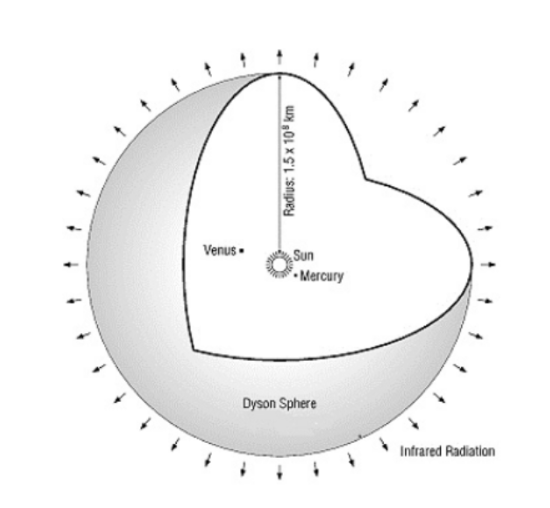Could the Dyson Sphere be the novel energy source the world is seeking?
On a clear night, do you look up to the sky and see an array of luminous stars? A potential sanctuary for humanity? Or, a population of aliens flourishing on various planets? English–American physicist Freeman Dyson looked to stars as a potential energy source to power the entire world’s energy usage for one year in under one second (5). He believed that by the year 3100, Earth’s population and technological advances would require a significant amount of energy each day, and power plants would not keep up with the pressing demands (7). In 1960, Dyson speculated a structure––the Dyson sphere––that would encircle stars around the galaxy, along with the Sun, accumulating light energy and transporting it back to Earth (7).
On the largest, theoretical scale, the Dyson sphere is constructed out of pulverized asteroids with solar collectors on the surface (1). The structure collects 400 septillion watts of energy per second from infra-red radiation, several trillion times more energy than the world uses in one year (1). However, creating said structure is currently out of reach due to the scale, materials needed, and technology.
Currently, researchers and scientists grapple with the idea of the Dyson sphere’s cousin, the Dyson swarm, for a sustainable energy alternative in the future (6). In this more probable scenario, the Dyson swarm’s man-made satellites orbit the star, similar to how the Earth revolves around the Sun (6). Also, solar panels on the surface of satellites collect the Sun’s radiation and transmit the solar rays back to Earth’s homes and metropolitan industries (6).

In the scientific community, finding success against gravity is a regular battle. The concern with the Dyson sphere and swarm is that the structures are not resistant to gravity. Across the world, variations for the original Dyson sphere are being researched and tested, and there are already promising results At the Bogazici University in Turkey, Ibrahim Semiz and Solim Ogure are testing a mechanism that could harness energy from older stars, known as white dwarfs (3). These stars are likely better candidates for a Dyson-like structure as they are smaller, yet have more gravity for potential, futuristic, and technologically-advanced civilizations.
Obtaining energy from stars seems to be an alternative to energy sources used today. Throughout a star’s life–span, the force of gravity causes a nuclear push, which provides an outward stimulus of energy for an average of ten billion years (4). With a constant flow of energy from stars, Dyson spheres are significantly better in terms of energy usage than the fossil fuels and nuclear energy used today. The Energy Information Association (EIA) states that fossil fuels make up 60.8% of energy sources in the United States and nuclear sources provide 18.9% (2). Respectively, each of these sources supplies 2,504 billion kilowatts ( billion kW) and 778 billion kW per year (2).

As our world faces climate change and stress on typical energy sources, it is provided with imaginative advances in technology. Dyson’s dream of the Dyson sphere may become a reality with variations that support humanity and the power of the greater universe.
Bibliography
- Fecht, S. (2017, May 1). Anatomy of a Dyson sphere. Popular Science, 289(3), 8. Retrieved from https://discovery.ebsco.com/c/yso3g4/viewer/html/5oj37xd6kr?modal=cite
- Frequently Asked Questions (FAQs) – U.S. Energy Information Administration (EIA). (2018). Eia.gov. Retrieved from https://www.eia.gov/tools/faqs/faq.php?id=427&t=3
- from, T. (2015, March 26). Physicists Describe New Class of Dyson Sphere. MIT Technology Review; MIT Technology Review. Retrieved from https://www.technologyreview.com/2015/03/25/249073/physicists-describe-new-class-of-dyson-sphere/
- Haynes, K. (2020, February 14). How do stars create and release their energy? Astronomy.com. Retrieved from https://astronomy.com/news/2020/02/how-do-stars-create-and-release-their-energy.
- Infinite possibilities; Freeman Dyson. (2020, March 14). The Economist, 434(9185), 74(US). Retrieved from https://link.gale.com/apps/doc/A617187977/ITOF?u=mlin_m_bucking&sid=ebsco&xid=42f90882
- Pomeroy, R. (2017, September 4). How to Build a Dyson Swarm. Space.com; Space. Retrieved from https://www.space.com/38031-how-to-build-a-dyson-swarm.html
- The Dyson Sphere. (2016). Stanford.edu. Retrieved from http://large.stanford.edu/courses/2016/ph240/wee1/
